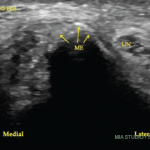A 66-year-old woman returns to the office for a follow-up visit. She is seen by the physician assistant (PA) for her rheumatoid arthritis. She is experiencing burning pain in her right knee, and she reports that after going for her morning walk, she rates the pain at a 6 on a scale of 10. She says that her other joints feel OK. The patient is currently taking methotrexate 7.5 mg orally once a week and adalimumab 40 mg once a week. She denies fevers, headaches, chest pain, dyspnea, cough, abdominal pain or gastrointestinal (GI) symptoms, oral ulcers, rashes or depression. She currently works full time at an accounting firm. She has had hypertension for 20 years, which is controlled with valsartan–hydrochlorothiazide.
Examination: The patient’s blood pressure is 125/88; her height is 5’6”; she weighs 225 lbs. and has a body mass index of 36.3; and her temperature is 97ºF. Her lungs are clear; her heart has a regular rate and rhythm with no murmurs or rubs. Her abdomen has no masses or tenderness.
Her right knee has crepitus and tenderness with her best effort at flexion. There is some bony enlargement. The knee joint feels warm to the touch, but has no synovitis or effusion. Her right knee lacks 10 degrees of full flexion and 5 degrees of full extension. When walking, her gait is uneven due to the pain in her right knee.
All other peripheral joints have good range of motion, no palpable synovitis or effusion, no deformities and no tenderness with palpation or motion. Her neck and back are not tender and move well.
Diagnosis: 1. Rheumatoid arthritis. 2. Right knee pain, possibly osteoarthritis. 3. Obesity.
Plan: The patient is given a prescription for tramadol 50 mg to take one twice daily as needed for knee pain; possible side effects are reviewed. After discussing treatment options with the patient, she agrees to have the knee injected with 40 mg methylprednisolone acetate. She is scheduled for an X-ray of her right knee the following week to confirm a diagnosis of osteoarthritis, and the possibility of an MRI is discussed, if needed, based on the plain X-ray and her response to the injection. The physician reviews and agrees with the plan and treatment for the knee pain. The patient is also given suggestions on how to incorporate daily physical activity into her schedule, including the possibility of water exercise, such as aerobics. She is also given recommendations for reducing fat and calorie intake, and the possibility of consultation with a dietician is discussed. She is requested to return in three months for a follow-up appointment, or sooner if needed.


